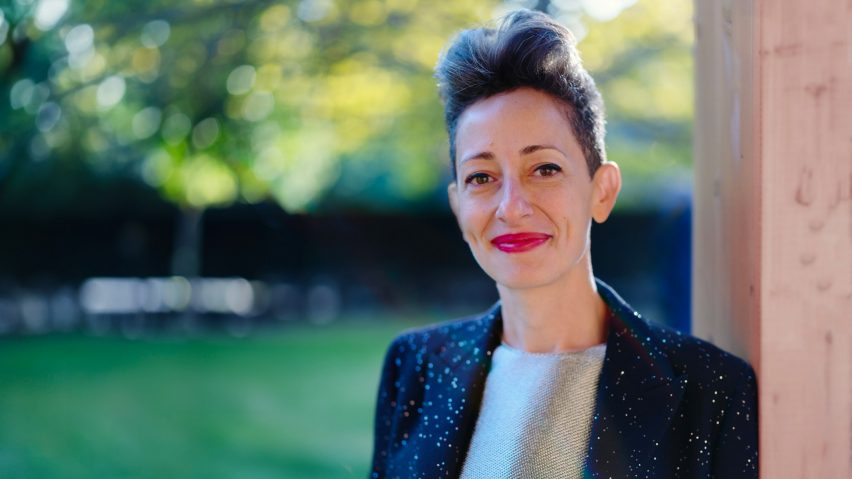Lebanese architect Lina Ghotmeh says that her restrained and environmentally conscious Serpentine Pavilion reflects current views on architecture in this exclusive interview.
Speaking to Dezeen at the opening of this year's Serpentine Pavilion in London's Kensington Gardens, Ghotmeh explained how she believes that each of the commissions since 2000 have reflected the eras they were built in.
"My first approach was to think about what the Serpentine commission actually is," she said.
"For me, it's about really a reflection of the times that we live in. Every pavilion, in a way, recalls the questions and challenges of the day."
"It's not about a pavilion that you can just shoot in one photo"
Built around a large communal table, Ghotmeh's pavilion was constructed from glued laminated timber (glulam) and birch plywood.
Designed as a place to gather, it sits below the level of the surrounding trees and neighbouring gallery and has views out to the surrounding parkland through fretted screens on all sides.
"I feel like my approach is more like an architecture that is emerging from its place that is more about the interiority of experience, actually, and that doesn't scream loud in its context," she said.
Ghotmeh designed the pavilion to be experienced in person rather than being a one-liner to be enjoyed in pictures, she explained.
"The approach to detail and the buildability of the structure is important, as is the depth of experience," she said. "It's not about a pavilion that you can just shoot in one photo and you have uncovered everything through it."
"It's really a layered experience – about one's memory, about the research that has gone into it, about the buildability, about understanding how it is done," she continued.
"If you build something it has to be worthwhile"
Another key factor in the design was sustainability, which early pavilions prioritised less.
"Previous pavilions were heavy on carbon footprint and thankfully we are more aware of that today," Ghotmeh said.
"It's urgent and that's what's interesting in this commission because you have very little time to think and build the project," she added. "This little time pushes one to think about the urgency of the moment, and you have to be able to react urgently to our climate disaster."
"So if you build something it has to be worthwhile, it has to also have a lightweight foundation, it has to be low carbon, it cannot just be like crazy construction without taking into account all this."
The focus on sustainability had a direct impact on the materials that were used to build the pavilion, with Ghotmeh choosing glulam to reduce the pavilion's carbon impact and create a lightweight structure that would require less substantial foundations.
"Also it is about limiting oneself with the materials that you can use," she said. "I didn't want to use steel, because of its carbon footprint. I was more conscious about what to use as a material and that of course also limits the shapes and what you can build."
"Beauty and the construction had to go hand in hand"
However, Ghotmeh doesn't believe that a focus on materials and reducing the carbon impact of buildings means that architecture can not be interesting or beautiful.
"[With this pavilion] beauty and the construction had to go hand in hand," she said.
"I don't think if we are sustainable and we are trying to build low carbon construction, that it has to be invisible."
Ghotmeh's pavilion is the 22nd Serpentine Pavilion to be built. Last year, Chicago artist Theaster Gates created a black chapel-like structure, which was one of the most sustainable ever.
Also designed to be fully removable from the site, Ghotmeh's pavilion will have a similar carbon impact and the architect hopes that future pavilions will push this concept even further.
"I think every year also what's important is that we are learning," she said. "As we move forward from one pavilion to another, we are learning and that's important. Each pavilion is a learning process. I hope the next one will even be pushing that further."
Dezeen in Depth
If you enjoy reading Dezeen's interviews, opinions and features, subscribe to Dezeen In Depth. Sent on the last Friday of each month, this newsletter provides a single place to read about the design and architecture stories behind the headlines.

